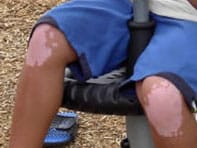The goal in treating vitiligo is to attempt to restore color (pigment) to your skin and improve your appearance. Depending on the type of therapy, treatment for vitiligo may take from six to 18 months. Treatment choices are based on the number of white patches you have and how widespread they are. Each person responds differently to treatment, and a particular therapy may not work for you.
Medical Therapies
Topical corticosteroid therapy. Corticosteroids may help return color to your skin (repigmenting), particularly if they’re started early in the disease. These drugs, which include cortisone, are similar to the hormones produced by your adrenal glands. Your doctor may prescribe a mild topical corticosteroid cream or ointment for children younger than 10 years old or a stronger form for adults. You may need to apply the cream or ointment to the white patches on your skin for at least three months before you see any results. This treatment is simple and safe, but your doctor will monitor you closely for side effects, such as skin shrinkage and streaks or lines on your skin (skin striae). Calcipotriene (Dovonex), a vitamin D derivative, also may be used topically and is sometimes used with corticosteroids or ultraviolet light.
Topical psoralen plus ultraviolet A (PUVA)
Topical PUVA may be a treatment option if you have a small number of depigmented patches (affecting less than 20 percent of your body). PUVA, also called photochemotherapy, is performed under artificial UVA light once or twice a week in your doctor’s office. Your doctor or a nurse will apply a thin coating of psoralen to the depigmented patches of your skin about 30 minutes before UVA light exposure. You’re then exposed to an amount of UVA light that turns the affected area of your skin pink. Your doctor may slowly increase the dose of UVA light over many weeks. Eventually, the pink areas of your skin fade and a more normal skin color appears.
Potential short-term side effects of topical PUVA therapy include severe sunburn and blistering and too much repigmentation or darkening of the treated patches or the normal surrounding skin (hyperpigmentation). You can minimize your chances of sunburn by avoiding exposure to direct sunlight after each treatment. Hyperpigmentation is usually a temporary problem and eventually disappears when treatment stops
Oral psoralen photochemotherapy (PUVA)
Oral PUVA therapy may be used if you have extensive vitiligo (affecting more than 20 percent of your body) or if you haven’t responded to topical PUVA therapy. Oral PUVA isn’t recommended for children younger than 10 years of age because of an increased risk of damage to the eyes, such as cataracts. For oral PUVA therapy, you take a prescribed dose of psoralen by mouth about two hours before exposure to artificial UVA light or sunlight. Your doctor adjusts the dose of light until the skin areas being treated become pink. Treatments are usually given two or three times a week, with at least one day in between.If you don’t have access to a PUVA facility, your doctor may prescribe psoralen to be used with natural sunlight exposure. Your doctor will give you careful instructions on carrying out treatment at home and monitor your progress with frequent office visits.
Short-term side effects of oral PUVA may include sunburn, nausea and vomiting, itching, abnormal hair growth, and too much repigmentation or darkening of the treated patches or the normal surrounding skin (hyperpigmentation). If received for longer periods of time, this type of treatment may increase your risk of skin cancer. To avoid sunburn and reduce your risk of skin cancer, you’ll need to apply sunscreen and avoid direct sunlight for 24 to 48 hours after each treatment. Wear protective UVA sunglasses for 18 to 24 hours after each treatment to avoid eye damage, particularly cataracts.
Narrow-band Ultraviolet “B” (nbUVB) therapy
In recent years, special lamps have become available that emit only the very small and specific frequency of ultraviolet B light (“narrowband”, or nbUVB) that is medically effective in treating Vitiligo. This has become preferable to PUVA, which is rapidly falling out of favor. nbUVB treatments are administered much like PUVA, only without the need for the psoralen medications. This greatly simplifies the process and eliminates the many undesirable psoralen-related side effects. Over the last several decades, nbUVB phototherapy has proven to be a much safer and longer-term alternative to PUVA. It carries virtually no negative side effects and appears to be effective for the large majority of Vitiligo sufferers. Plus, as there are no medications required, home nbUVB systems are now a very practical reality to provide long-term regimentation for most people in the privacy of their own home (and without continual co-payments and trips to the office).
Depigmentation
Depigmentation involves fading the rest of the skin on your body to match the already-white areas. If you have vitiligo on more than 50 percent of your body, depigmentation may be the best treatment option. In this procedure, the drug monobenzone (Benoquin) is applied twice a day to the pigmented areas of your skin until they match the already-depigmented areas. Avoid direct skin-to-skin contact with others for at least two hours after applying the drug.
The major side effect of depigmentation therapy is redness and swelling (inflammation) of the skin. You may experience itching, dry skin or abnormal darkening of the membrane that covers the white of your eyes. Depigmentation is permanent and cannot be reversed. In addition, if you undergo depigmentation you will always be extremely sensitive to sunlight.


